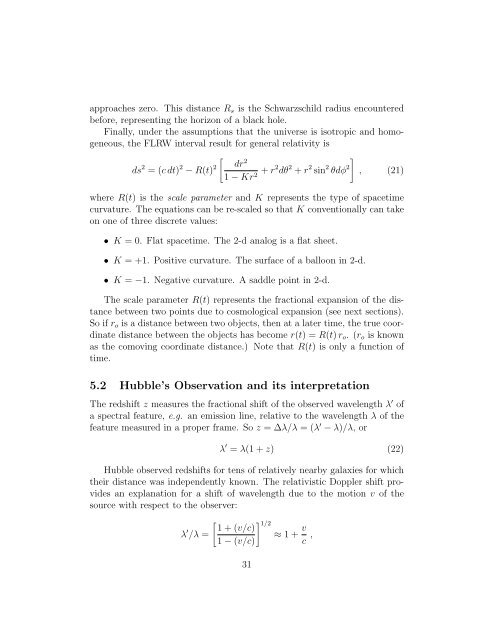Lecture Notes for Astronomy 321, W 2004 1 Stellar Energy ...
Lecture Notes for Astronomy 321, W 2004 1 Stellar Energy ...
Lecture Notes for Astronomy 321, W 2004 1 Stellar Energy ...
You also want an ePaper? Increase the reach of your titles
YUMPU automatically turns print PDFs into web optimized ePapers that Google loves.
approaches zero. This distance R s is the Schwarzschild radius encountered<br />
be<strong>for</strong>e, representing the horizon of a black hole.<br />
Finally, under the assumptions that the universe is isotropic and homogeneous,<br />
the FLRW interval result <strong>for</strong> general relativity is<br />
[<br />
ds 2 = (c dt) 2 − R(t) 2 dr 2<br />
]<br />
1 − Kr + 2 r2 dθ 2 + r 2 sin 2 θdφ 2 , (21)<br />
where R(t) is the scale parameter and K represents the type of spacetime<br />
curvature. The equations can be re-scaled so that K conventionally can take<br />
on one of three discrete values:<br />
• K = 0. Flat spacetime. The 2-d analog is a flat sheet.<br />
• K = +1. Positive curvature. The surface of a balloon in 2-d.<br />
• K = −1. Negative curvature. A saddle point in 2-d.<br />
The scale parameter R(t) represents the fractional expansion of the distance<br />
between two points due to cosmological expansion (see next sections).<br />
So if r o is a distance between two objects, then at a later time, the true coordinate<br />
distance between the objects has become r(t) = R(t) r o . (r o is known<br />
as the comoving coordinate distance.) Note that R(t) is only a function of<br />
time.<br />
5.2 Hubble’s Observation and its interpretation<br />
The redshift z measures the fractional shift of the observed wavelength λ ′ of<br />
a spectral feature, e.g. an emission line, relative to the wavelength λ of the<br />
feature measured in a proper frame. So z = ∆λ/λ = (λ ′ − λ)/λ, or<br />
λ ′ = λ(1 + z) (22)<br />
Hubble observed redshifts <strong>for</strong> tens of relatively nearby galaxies <strong>for</strong> which<br />
their distance was independently known. The relativistic Doppler shift provides<br />
an explanation <strong>for</strong> a shift of wavelength due to the motion v of the<br />
source with respect to the observer:<br />
λ ′ /λ =<br />
[ ] 1/2<br />
1 + (v/c)<br />
≈ 1 + v 1 − (v/c) c ,<br />
31













